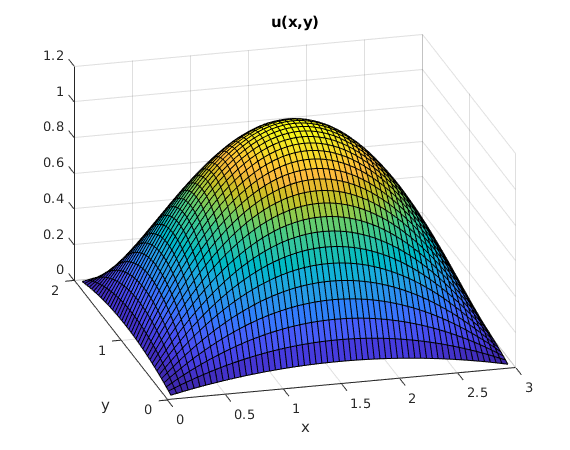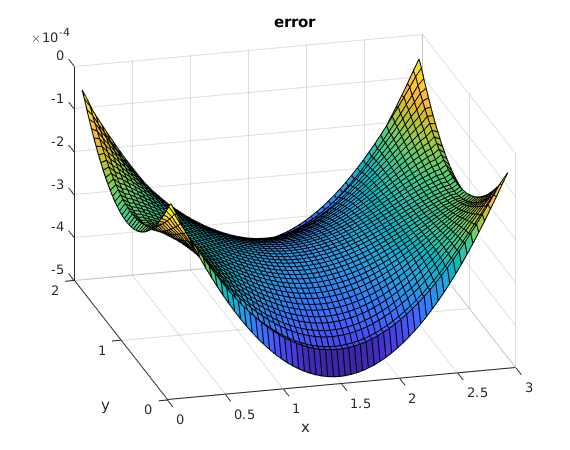Solving the Poisson Equation (Dirichlet case) using the Discrete Sine Transform
Contents
You first have to download m-files
Download the m-files sintr.m , isintr.m and put them in the same directory as your other m-files.
Solve the Poisson equation  in a rectangle
in a rectangle
We are given a "forcing function"  for
for ![$x\in [0,A]$](PoissonD_eq06895032831639178498.png) ,
, ![$y\in[0,B]$](PoissonD_eq10287963619840255830.png) . We want to find a function
. We want to find a function  for
for ![$x\in [0,A]$](PoissonD_eq06895032831639178498.png) ,
, ![$y\in[0,B]$](PoissonD_eq10287963619840255830.png) such that
such that

We prescribe Dirichlet boundary conditions on all four sides of the rectangle:


We write the solution  as a sine series for both x and y: With
as a sine series for both x and y: With  and
and 

From this we get

This gives the following Solution Formula: First find the sine series of  for both x and y:
for both x and y:

Define for  the coefficients
the coefficients  , then the solution
, then the solution  is given by the above sine series in x,y.
is given by the above sine series in x,y.
Example: For a rectangle with lengths  and
and  we are given the forcing function
we are given the forcing function  .
.
A=3; B=2; % lengths of rectangle sides f = @(x,y) x.*(x-A)+y.*(y-B); % given forcing function f(x,y) M = 60; % use spacing A/M for x x = A*(1:M-1)/M; % only interior nodes N = 40; % use spacing B/N for y y = B*(1:N-1)/N; % only interior nodes [X,Y] = ndgrid(x,y); F = f(X,Y); % F is array of values of f on grid: F(j,k) = f(x_j,y_k) bx = sintr(F); % apply sine transform to columns b = sintr(bx')'; % apply sine transform to rows mu = (1:M-1)*pi/A; % vector of mu_k nu = (1:N-1)*pi/B; % vector of nu_l [Mu,Nu] = ndgrid(mu,nu); C = -b./(Mu.^2+Nu.^2); % solution formula in frequency domain Cx = isintr(C')'; % apply inverse sine transform to rows U = isintr(Cx); % apply inverse sine transform to columns surf(x,y,U'); % make surface plot of solution xlabel('x'); ylabel('y'); title('u(x,y)') view(-15,30);

Plot error
In this case we actually know the exact solution  . We can plot the difference of the computed solution and the exact solution, and we see that the error is of the order
. We can plot the difference of the computed solution and the exact solution, and we see that the error is of the order  . We can decrease the error by using higher values of
. We can decrease the error by using higher values of  .
.
Uex = X.*(A-X).*Y.*(B-Y)/2; % evaluate exact solution on grid surf(x,y,(U-Uex)'); % make surface plot of U-Uex xlabel('x'); ylabel('y'); title('error') view(-15,30);
